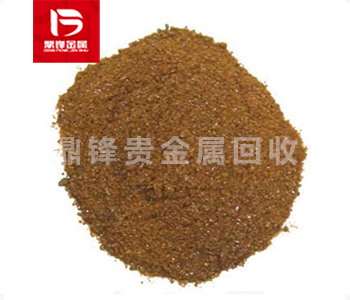
Palladium Salt Recycling
Palladium salts typically exhibit white or yellow crystals with good solubility. Its melting point is relatively high, about 1554 ℃, and its density is 11.99 g/cm ³。 Palladium salts have good conductivity and thermal conductivity, making them an excellent catalyst material. Palladium salts are relatively stable in air, but are easily oxidized by oxidants such as nitric acid. It can form compounds with many non-metallic elements, such as Palladium(II) sulfide and Palladium(II) chloride. Palladium salts are usually divalent, and their Oxidation state can be+2 or+4.
- Parameter
- Related Questions and Answers
-
Name : Palladium salts
-
Use : catalyst,electronics, electroplating
-
Application Areas : Chemical catalysis, electronics, electroplating, automobiles, medicine and new energy
-
Appearance and properties : Red or orange crystals or powder
-
Settlement Method : On site payment
-
Recycling Type : Palladium recycling
-
Door-to-door recycling:worldwide
-
Customer service: Free content testing and door-to-door recycling
Palladium Tube Recycling
A tube made of metallic palladium is called a palladium tube (palladium alloy tube), and the size of the palladium tube used is mostly φ 20.08mm, can be used for the separation of hydrogen and impurities. The principle of palladium tube purification of hydrogen is that at 300-500 ℃, when the hydrogen to be purified is introduced to the other side of the palladium tube, the hydrogen is chemically adhered to the wall of the palladium tube and dissociated into hydrogen atoms. The hydrogen atoms and palladium atoms form alloy type hydrides, and the hydrogen atoms occupy the gap edges in the metal lattice, also known as interstitial hydrides. Under the promotion of concentration gradient, hydrogen atoms can spread through the walls of palladium tubes, forming a hydrogen molecular color layer again after passing through the tubes.
Search : Palladium Tube RecyclingPalladium Powder Recycling
Palladium powder is a small and granular palladium metal powder obtained by special treatment of high-purity palladium metal. It has a gray white appearance, good chemical stability, and high temperature resistance. The preparation of palladium powder is usually achieved through methods such as chemical reduction, thermal reduction, or mechanical grinding, and has the characteristics of high purity and uniform particle size.
Search : Palladium Powder RecyclingWaste Palladium Carbon Recycling
Palladium on Carbon (Pd/C) is a supported palladium catalyst in which palladium metal is loaded onto high-surface-area activated carbon. It appears as a black or dark gray powder and is widely used in organic synthesis, pharmaceuticals, petrochemicals, and environmental protection. Pd/C is known for its high catalytic efficiency, stability, and recoverability, making it an essential catalyst in various industries.
Search : Waste Palladium Carbon RecyclingPalladium Catalysts Recycling
A palladium catalyst is a chemical catalyst that uses palladium (Pd) as its active component, typically supported on materials such as alumina, activated carbon, silica, or zeolite. It is widely used in various industries due to its excellent catalytic properties.Recycling methods include acid leaching, solvent extraction, high-temperature smelting, and electrolysis, which allow for the recovery and refining of palladium to a purity of 99.95% or higher.
Search : Palladium Catalysts RecyclingProduct Details
Palladium salts typically exhibit white or yellow crystals with good solubility. Its melting point is relatively high, about 1554 ℃, and its density is 11.99 g/cm ³。 Palladium salts have good conductivity and thermal conductivity, making them an excellent catalyst material. Palladium salts are relatively stable in air, but are easily oxidized by oxidants such as nitric acid. It can form compounds with many non-metallic elements, such as Palladium(II) sulfide and Palladium(II) chloride. Palladium salts are usually divalent, and their Oxidation state can be+2 or+4.
The types of palladium salts are as follows:
1. Palladium(II) chloride: Palladium(II) chloride is one of the most common palladium salts, and its chemical formula is PdCl2. It is a colorless crystal with good solubility in water. Palladium(II) chloride is widely used in organic synthesis and catalyst preparation.
2. Palladium Nitrous acid: Palladium Nitrous acid is a white crystal with the chemical formula Pd (NO3) 2. It has a high solubility in water and can be used as a precursor for catalysts, especially in oxidation reactions in organic synthesis.
3. Palladium acetate: Palladium acetate is a yellow crystal with the chemical formula Pd (OAc) 2. It has good solubility in organic solvents and is often used in organic synthesis reactions, especially in Coupling reaction.
4. Palladium(II) nitrate: Palladium(II) nitrate is a colorless crystal with the chemical formula Pd (NO2) 2. It has a low solubility in water and is commonly used in organic synthesis and catalyst preparation.
5. Palladium(II) oxide: Palladium(II) oxide is a brown precipitate with the chemical formula Pd (OH) 2. It has limited solubility in water and is often used in the preparation of catalysts and some Organic reaction.
Waste palladium salts are one of the sources of recovery of palladium containing noble metal catalysts. The recovery sources of palladium containing noble metal catalysts include Palladium(II) oxide recovery, Palladium(II) chloride recovery, Palladium(II) nitrate recovery, Palladium(II) bromide recovery, Palladium(II) oxide hydrogen recovery, palladium sulfate recovery, etc. If you have any demand for palladium containing waste recycling, please call our 24-hour service hotline. Dingfeng Precious Metal Recycling and Refining Factory has independent recycling and refining factories without intermediaries to earn price differences. Our professional technical team and customer service personnel provide one-on-one services to ensure customer privacy during the recycling process.

